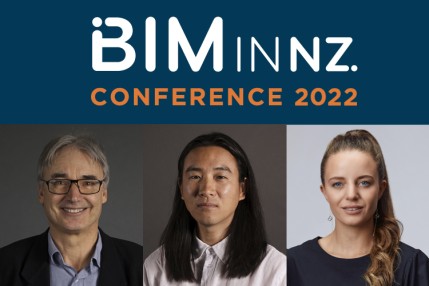
Over the next few editions of News from the Source, we will be profiling our BIMinNZ Conference speakers. In our Sustainability Programme Stream, Chris Scott and Jun Tsujimoto from Jasmax will be presenting a case study on the adaptive reuse and sustainability in the University of Auckland B201 project, and Emily Newmarch, a PhD candidate at Victoria University of Wellington will be presenting on BIM-enabled carbon calculation.
University of Auckland B201: Case Study on adaptive reuse and sustainability
The University of Auckland B201 project has achieved NZGBC 6 stars at design stage, with the highest number of points for any building in Aotearoa New Zealand. This presentation will reveal the design process, the evolution of design principles, and how these are manifest in the design.
The project started with a series of integrated design workshops and rapid testing of options to establish the fundamental design solutions, prove the project feasibility and achieve the master plan objectives, alongside establishing outstanding sustainability goals and identifying place-based cultural narratives. These are all now embedded in the design, which has not deviated from the original framework. With the University of Auckland, Jasmax, and Beca all involved in the process, the project had the benefit of institutional knowledge, design expertise and a shared determination to innovate.
About the speakers:
Chris Scott – Principal / Registered Architect, Jasmax
With over 30 years’ experience in architecture, Jasmax Principal Chris Scott is one of New Zealand’s leading education design specialists and co-leads the Education team at Jasmax. His expertise has contributed to the creation of highly innovative learning environments that are changing the educational experience of students in New Zealand.
Over the past 12 years, Chris has been responsible for the design and delivery of major developments for three major New Zealand universities. Past projects include the Sir Paul Reeves and Ngā Wai Hono buildings for AUT, and more recently, the 450-bed Te Rangi Hiroa College student accomodation building – the first new college designed for Otago University in 50 years.
Currently working closely with AUT and the University of Auckland (UoA), Chris is currently leading AUT’s A1 project for the Faculty of Health and Environmental Sciences and UoA’s proposed 6-Star Green Star-rated B201 building for the Faculties of Arts, Education and Social Work.
Both these projects start with the adaptive reuse of 40-year-old buildings. Integrated with new engineered timber structures to increase and augment activities, each project provides a realistic, achievable roadmap toward a low carbon future.
Jun Tsujimoto – Principal / Registered Architect, Jasmax
Jun Tsujimoto focuses on architecture that has the potential to influence and shape cities. He is inspired by both institutional and community led initiatives that act as a catalyst for urban regeneration, and the role that architecture plays in support of this process.
Jun provides design leadership across the Jasmax, working alongside our interdisciplinary project teams to develop robust conceptual frameworks that help clients achieve their objectives. Jun has an impressive portfolio of work, encompassing boutique fitouts and residential projects, tertiary education, civic buildings, and urban infrastructure in both New Zealand and Japan.
Jun’s projects include the completed AUT Sir Paul Reeves and Ngā Wai Hono (Engineering, Computing and Mathematical Sciences) Buildings, the New Zealand Pavilion for Expo 2020 in Dubai, the future Waikato Regional Theatre, Auckland’s CRL (City Rail Link), and the University of Auckland’s B201 building. Each unique project demonstrates Jun’s aptitude for achieving design clarity on projects of significant scale and complexity.
Delivering Net-Zero: BIM enabled carbon calculation
The iconic question, how much does your building weigh? Is becoming of increasing importance when aiming to understand the environmental impact of buildings during early design. The question is rapidly transforming into how much embodied carbon does your building emit before the client gets the keys? And how do we access this information during the critical early design stages? For many who engage with digital (BIM) workflows, the answer is already sitting on your desktop. Many 3D models built to explore the initial vision hold enough information to calculate the amount of embodied carbon to inform low-carbon design decisions.
This presentation will showcase the potential of using a BIM workflow to enable embodied carbon analysis in the early design stages. The real-world case studies presented will demonstrate the integration of carbon tools to actively calculate embodied carbon during all design stages, with a specific focus on early testing and rapid digital prototyping to advance both understanding and measurable reporting required for low-carbon Construction.
The presentation will also highlight the use of automation and AI through machine learning to improve accessibility, speed and accuracy of the carbon analysis resulting in a more significant number of project typologies being assessed, potentially pathing the way forward for a national carbon benchmark to be established. Overall, this project highlights the vital role BIM and accurate and open digital information plays in enabling New Zealand's low carbon future, underscoring the urgency to advance the education, adoption and integration of BIM and digital workflows across the entire construction sector.
About the speaker:
Emily Newmarch – PhD candidate, Victoria University of Wellington
Emily‘s PhD research project represents a partnership with Warren and Mahoney to explore the possibilities of low carbon design for the industry. Specifically, her research is focused on understanding the way we can measure, design and value architecture for a low carbon future.
Emily‘s previous research focused on the integration of thermal performance analysis within different BIM enabled software. Through her work in this area of investigation, she has been published internationally on scientific platforms, while Emily has also been the recipient of awards for design.
Outside of her studies, Emily has been involved with teaching students design processes, environmental design, construction, and research methodologies.
To view the full Programme and register to attend, visit biminnz.co.nz/conference









